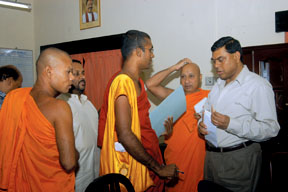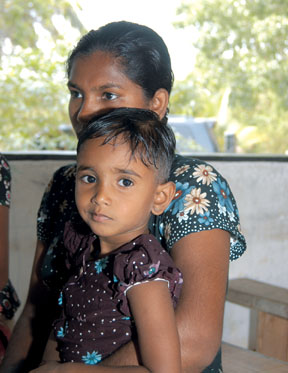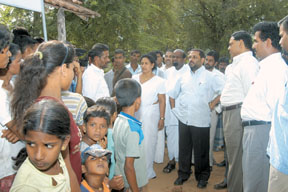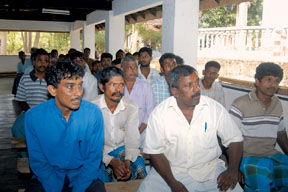|
observer |
|
|
|
|
|
OTHER LINKS |

|

|

|
Jathika Saviya: movement to empower people
Terrorism does not care for age sex and racial differences. It is a strange phenomenon that when terrorists explode a bomb or carry out a massacre, if it is a village area its inhabitants would abandon their belongings and seek refuge in a safer place. On the contrary, in a similar situation, the town becomes mere resilient and nomalcy returns within days! After the gruesome deaths the villagers in Padaviya and Sripura moved out into safer areas. IT was President Mahinda Rajapaksa who diagnosed the problems and suggested the remedy. His concept of 'Jathika Saviya' (National Strength) prescribes the provision of necessary amenities to areas vulnerable to terror attacks and strengthen the lives of its inhabitants, so that the gravity of the problem could be mitigated. The national Programme was inaugurated in June 2006. Programme for IDPsThe improvised system of providing temporary accommodation with dry provisions to victims has since been replaced with the new technique of identifying the problems faced by the villagers and providing suitable solutions. Much emphasis has been laid on such basic needs each as electricity, road network, water, health facilities, education and transport. Ensuring inter-departmental and non-governmental agency co-ordination for implementation of programmes is a salutary feature with blueprint. The National Programme, Jathika Saviya appears to be heralding a new era for the people in difficult areas. Whilst new infrastructure facilities are being provided, repairs and maintenance undertaken and humanitarian needs of the IDPs attended to, a special programme was launched to commemorate the refugees from Kebitigollawa, Mutur, Kantale, Seru Nuwara, Vakarai, Eechalanpattu. It was also victory that the IDPs from Kebitigollawa and Mutur could be resettled in their old habitats. The scope of the new Jathika Saviya has been expanded to embrace, Anuradapura, Polonnaruwa, Trincomalee, Batticaloa, Ampara, Puttalam, Moneragala, Vavuniya, Jaffna and Kilinochchi. Political parties of different hues, organisations private sector and particularly Muslims and Tamil political parties have contributed their lot for the success of the programs. The President and his government's basic theme is, that the country's development be expanded at village level so that the villagers would themselves enjoy its results. The Jathika Saviya programme which started from Anuradhapura has been extended to the terrorist infested northern and eastern districts as well. Most of the projects undertaken under the programme have nearly been completed. Following the bomb explosion, the Kebitigollawa hospital was provided with a high powered generator and a large consignment of medicine and medical equipment on the presidential directive. Medical facilities in the Anuradhapura district was largely improved. Forty new electricity schemes, 30 road development projects, 600 temporary and permanent housing units were undertaken in addition to 31,000 roofing sheets, 200 water tanks, four large water bowsers, and four construction machines have been supplied to be Anuradapura District. Electricity for villagesThe transport system within the district was improved with 10 new buses deployed and old buses being repaired. To strengthen the agriculture, tanks and waterways were renovated. Over 50 ambulances and about 100 double cabs have been supplied to the Northern and Eastern districts. The Jathika Saviya has undertaken 150 electricity schemes so far in these areas. From Habarana to Trincomalee, Mahakkenkada and Agbopura village and all rural hospitals in Vavuniya district have already been supplied with electricity. Eighty to 150 projects have been completed. With the supply of electricity and other amenities a new lease of life has begun to dawn upon the villagers. Development of road networkOf the 200 road development projects undertaken work on over 100 have already been completed to at least mitigate the vigours of ramshackled road network in remote areas. Work on 380 kilometres of the Ganagalle Galapitigala road has been completed. Alla-Kantale (33 km) Trincomalee outer circular road (55 km) etc. have been completed. A new system to undertake the maintenance of new and renovated roads is in operation. Sixty new buses have been put in service on these roads, in addition to 70 being repaired. HousingAround 1,065 new housing units have been constructed to provide permanent shelter to the villages. Three hundred and forty housing units at Kalawanchikude where the housing problem is acute are being constructed. In addition, 50,000 roofing sheets have also been distributed. SchoolsOf the 2,700 primary and secondary schools in Northern and Eastern areas and 'threatened' villages, many have been closed by now. The rest, continued with numerous drawbacks, have been provided with new buildings and libraries, computers and laboratory equipment. To meet the challenge of teacher shortage a special co-ordinating programme has been undertaken. Under the Mahinda Chintanaya, mid day meals to all schools have been supplied. Visit to villagesI found on my visit, that the incumbents in these areas were in dire need of infrastructure development and installing a sense of security in them. They were not however ready to depend on government subsidies. It is true because, with their sturdy limbs they were used to cultivate the land and reap the harvest for their substance, independent of others. Twenty five small and medium scale agrarian projects have been renewed to serve as a fillip to their labour to harness the resources. Combination of community halls, rural libraries and rural cultural homes and improvement to places of religious worship have been initiated in pursuit of spiritual development of the communities. To ameliorate the communication facilities, over 100 CDMA telephones have been supplied to selected areas. CommunicationThe chief operations room to man the Jathika Saviya is installed at the President's Office and it functions under the complete superintendence of the President. The administrative nucleus consists of a national committee and Provincial and Divisional Committee. Progress is reviewed at regular interval and programs are planned for the future. Today unlike in the past we are armed with a practical programme. A new course has been chartered for the future. The road to peace is now clear. It has a target and proper guidance with correct leadership. If the 'threatened villages' would be developed with their inherent problems mitigated, peace will certainly dawn on them permanently. |












